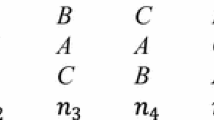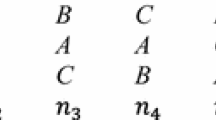Abstract.
Consider an election on three candidates for n voters with complete and transitive preference rankings on the candidates. Let k (r) denote the minimum total number of last (middle) position rankings for each of the three candidates. If k is close to zero, some candidate is seldom disliked and is a unifying candidate. If r is close to zero, some candidate is always either liked or disliked and is a polarizing candidate. A procedure is developed to obtain representations for conditional probabilities of election outcomes, when parameters like k or r are specified. Representations are obtained for the conditional probability that a pairwise majority rule winner, or PMRW, exists, given k and given r. Results show significant differences in the impact that unifying and polarizing candidates have on the probability that a PMRW exists.
Similar content being viewed by others
Author information
Authors and Affiliations
Corresponding author
Additional information
Received: 19 February 2004, Accepted: 29 September 2005
JEL Classification:
D7
A preliminary version of this paper was presented at the Bosphorus Workshop on Economic Design and at the Abdus Salam International Center for Theoretical Physics. Comments from participants at both presentations were very helpful in developing the final version of the paper.
Rights and permissions
About this article
Cite this article
Gehrlein, W.V. Probabilities of election outcomes with two parameters: The relative impact of unifying and polarizing candidates. Rev. Econ. Design 9, 317–336 (2005). https://doi.org/10.1007/s10058-005-0132-z
Issue Date:
DOI: https://doi.org/10.1007/s10058-005-0132-z




